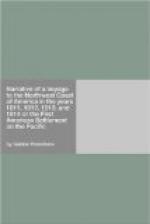[Illustration: ENTRANCE OF THE COLUMBIA RIVER. Ship Tonquin, crossing the bar, 25th March 1811.]
Although it was calm, the sea continued to break over the reef with violence, between Cape Disappointment and Point Adams. We sent Mr. Mumford (the second mate) to sound a passage; but having found the breakers too heavy, he returned on board about mid-day. Messrs. M’Kay and D. Stuart offered their services to go ashore, to search for the boat’s crew who left on the 22d; but they could not find a place to land. They saw Indians, who made signs to them to pull round the cape, but they deemed it more prudent to return to the vessel. Soon after their return, a gentle breeze sprang up from the westward, we raised anchor, and approached the entrance of the river. Mr. Aikin was then despatched in the pinnace, accompanied by John Coles (sail-maker), Stephen Weeks (armorer), and two Sandwich-islanders; and we followed under easy sail. Another boat had been sent out before this one, but the captain judging that she bore too far south, made her a signal to return. Mr. Aikin not finding less than four fathoms, we followed him and advanced between the breakers, with a favorable wind, so that we passed the boat on our starboard, within pistol-shot. We made signs to her to return on board, but she could not accomplish it; the ebb tide carried her with such rapidity that in a few minutes we had lost sight of her amidst the tremendous breakers that surrounded us. It was near nightfall, the wind began to give way, and the water was so low with the ebb, that we struck six or seven times with violence: the breakers broke over the ship and threatened to submerge her. At last we passed from two and three quarters fathoms of water to seven, where we were obliged to drop anchor, the wind having entirely failed us. We were far, however, from being out of danger, and the darkness came to add to the horror of our situation: our vessel, though at anchor, threatened to be carried away every moment by the tide; the best bower was let go, and it kept two men at the wheel to hold her head in the right direction. However, Providence came to our succor:




